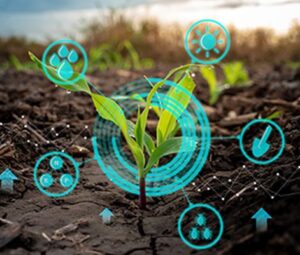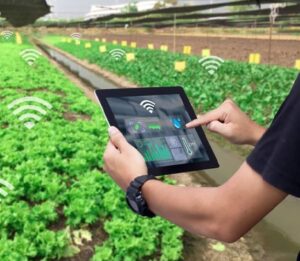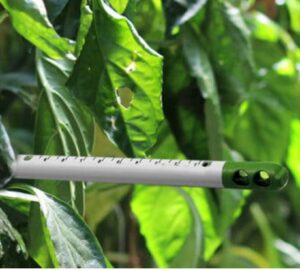Smart Sensors In Agriculture: Agriculture is being affected by rapid population growth, weather changes, decreased rainfall, and the demand for excess food to sustain billions of people around the world. Those practices have negative impacts on traditional farming. Agriculture is getting smarter with the introduction of smart sensors.
Currently, farming is being pushed to become more “smart” by using modern and intelligent technologies. In order to meet the ever-increasing consumption needs of the global population, we must find solutions to maximize resource utilization.
A smart sensor can provide farmers with real-time information about the crops, the environment, and the ecosystem, allowing them to monitor and optimize their crop production.
It is possible to separate and treat sick cows while locating and tracking their herd with the help of a smart agriculture sensor, which helps with animal identification, heat detection, and health monitoring. The use of smart sensors improves farmers’ understanding of their crops and their productivity, helps them sustain resources, and allows them to prevent or control the impact of the crops on the environment.
Read More :Boost Your Immune System With These Summer Fruits and Vegetables
Why are sensors important in agriculture?
Agriculture sensors are used for smart farming in agriculture.
Farmers can monitor and optimize crops based on environmental conditions and challenges with their help.
Farmers use these sensors in weather stations, drones, and robots to monitor the weather.
It is possible to control them precisely with mobile apps, which are developed specifically for this purpose.
Agricultural sensors that are wirelessly connected. These sensors can be controlled via mobile phone applications or directly through Wi-Fi.
Types Of The Sensors In Agriculture
An analog or digital sensor measures or detects natural world conditions, like motion, heat, or light, and converts them into analogue or digital data.
The use of sensors in agriculture for smart agriculture incorporates many types.
1. Optical Sensors In Agriculture

A variety of frequencies of light is used to determine soil properties. The sensors are mounted on vehicles or drones, allowing soil reflectance and plant colour data to be gathered. The content of clay, organic matter, and soil moisture can be determined using optical sensors.
2. Electrochemical Sensors For Soil Nutrient Detection

This tool is used to collect soil chemical data. In order to detect soil nutrients, electrochemical sensors are used. The soil samples are sent to a lab for testing. A pH measurement is carried out with an ion-selective electrode. A particular ion, such as nitrate, potassium, or hydrogen, is detected by these electrodes.
3. Mechanical Soil Sensors For Agriculture

A pressure scale or load cell measures the force using a mechanism that cuts through the soil.
In the course of cutting, breaking, and dislodging soil, a sensor records the hold forces that result. Measured in units of pressure, soil mechanical resistance is the ratio between the force required to enter the soil medium and the frontal area of the tool engaged with the soil.
4. Dielectric Soil Moisture Sensors

The device measures soil moisture levels. Rain check locations around the farm are used with the moisture sensors. Low vegetation levels allow for observation of soil moisture conditions.
5. Location Sensors In Agriculture

A sensor determines the range, distance, and height of a particular position within a given area. This is done with the help of GPS satellites.
6. Electronic Sensors

To check how field equipment operates, it is attached to tractors and other equipment. The data is then sent directly to computers or emailed to people via cellular and satellite communication systems. When the field executive returns to the office, the information can be retrieved on his computer or cell phone.
7. Airflow Sensors

While on the move, it can be used to make measurements at particular locations. The desired output is the pressure needed to push a determined amount of air into the ground. Different soil properties, including compaction, structure, soil type, and moisture level, produce different identifying signatures.
8. Agriculture Sensors IOT

In addition to measuring and recording air temperature, soil temperature at various depths, rainfall, leaf wetness, chlorophyll, wind speed, dew point temperature, wind direction, relative humidity, solar radiation, and atmospheric pressure, this sensor provides information at periodic intervals.
There is a big list of sensors used in agriculture IOT sensors which means (Solutions for Smart Farming).
(a) Monitor the weather conditions
(b) Automation of greenhouses
(c) Managing crops
(d) Cattle Management And Monitoring
(e) Smart Precision Based Agriculture Using Sensors
(f) Agricultural Drones
Read More: A Complete Information About Protected Cultivation in India
How do Agriculture Sensors Help Small Scale Farmers?
Small-scale farmers can benefit from agricultural sensors by using a wide range of tools and devices.
There are some farmers who cannot afford all these agricultural sensors. A smartphone is the only cost that farmers must bear, and that is only a small amount. There are a number of applications on a smartphone that work exactly as sensors for your fields. This can save them the expense of all those sensors.
So let’s know about all those phone applications and their tools also.
| Smartphone Tools | Smartphone Applications |
| GPS | Provides location for mapping crops, location alerts for disease/pest, solar radiation predictions, and fertilizing. |
| Camera | Provides pictures of leaf health, lighting, brightness, and ripeness level. Also used for measuring Leaf Area Index (LAI) and measuring soil organic. |
| Microphone | It helps to predict maintenance of machinery. |
| Accelerometer | It helps to determine Leaf Angle Index. |
Uses Of The Sensors In Agriculture
The following sensors are used in smart farming:
In agriculture sensors, IoT, or agricultural weather stations, they are used. Sensors on these devices provide information about soil temperature, air temperature, rainfall, leaf wetness, chlorophyll, wind direction, solar radiation, relative humidity, atmospheric pressure, etc.
-
These sensors are used by agro-based industries to measure trunk diameter, leaf wetness, and many other farming applications.
-
The sensors in smart agriculture drones are used to spray pesticides and insecticides on the crops.
-
Farmer’s love solar-powered pumps because of their easy mobility to reduce electricity expenses.
-
Rural India has become very popular with e-fences, which keep animals out of crops.
Advantages Of Sensors In Agriculture
Agriculture Sensors have many advantages from which you can benefit.
Agricultural sensors were developed to meet the increasing demand for food while consuming a minimum amount of water, fertilizer, and seeds.
-
Their ease of use and maintenance make them ideal for beginners.
-
The best quality and lowest price are found in sensors.
-
Their fields and crops can be measured for pollution and global warming using these instruments.
-
Remote control is possible with these sensors, as they are equipped with wireless chips.
How does the use of Sensors in Agriculture can help the farmers in a futuristic way?
Agriculture robots and technologies now commonly used by farmers, labour shortages, and the need to feed an increasing global population.
As a result of lower costs of smart sensors and the vision and mission of machine education, robots and sensors can now see and train their surroundings.
The use of online cloud services and dashboards allows farmers to monitor their fields’ pest groups remotely and take immediate action to protect their crops
Things To Consider Before Starting Smart Sensors In Agriculture System
We can see that sensors can be used in agriculture in a multitude of ways. It is possible to increase the performance, productivity, and revenue of your farm through the use of smart devices in many ways. It is not for everyone, however, to operate and utilize Agriculture Sensors.
The use of sensors in agriculture and smart farming has specific challenges, which need to be understood before investing.
Choose Sensor For Your Device
Choosing the right sensors for your device is the first step in creating a clarification for agriculture. The type of information you want to gather and the purpose of your solution will determine what you choose. It is important that the data collected by your sensors is accurate and authentic for the success of your product.
Brain Of Your Device
Every smart sensor in agriculture solution should focus on data analytics. In order to derive actionable insights from the obtained data, you need convincing data analytics capabilities as well as algorithms and machine learning.
Maintenance Of Your Device
The maintenance of your sensors is essential if they are used in the field and are susceptible to damage. It is important to choose a durable and easy-to-maintain device in this situation. If you do not replace your sensors frequently, you will have to replace them more frequently than you would like.
Mobility Of Device
A smart farming application should be used in the field. All information should be accessible from a smartphone or desktop computer, either on-site or remotely.
In order to send data to the main server, each device should be independent and have a sufficient wireless range.
Reliable Infrastructure For Your Device
In order for your smart farming application to perform well, you have to have a reliable internal infrastructure.
The internal systems of your company must be completely secure. You increase your chances of losing data or even taking control of your field sensors if you fail to properly secure your system.
Connectivity Of Your Device
Smart farming is challenging due to the need to transfer data between many agricultural devices and facilities. To ensure uninterrupted operations, these facilities need a reliable connection that can withstand bad weather conditions.
It is our hope that the information provided here is adequate and reliable. You will definitely benefit from this information as you shop for a smart and reliable agriculture sensor. Aarug Agro provides information about smart farming, profitable agriculture, and sensors in agriculture.


